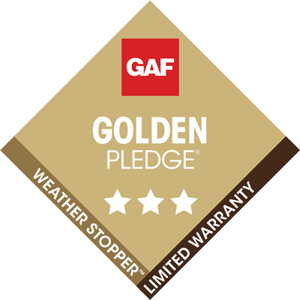Warranty Guide
What's covered by a roofing warranty?
As you’re doing your research you will likely come across two types of warranties—shingle warranties provided by the manufacturer and workmanship warranties offered by the roofing company performing the installation.
Shingle Warranties (Manufacturer): Your manufacturer’s shingle warranty is intended to provide coverage against product or manufacturing defects for a certain length of time, usually 20 to 50 years, ensuring that the manufacturer will make the necessary repairs or replacements to defective parts within that term.
Workmanship Warranties (Roofer): The workmanship warranty from your roofing company is in place to cover any errors or faults in the workmanship for a pre-designated duration.

Frequently Asked Questions about Shingle Warranties
-
What does ‘lifetime’ mean?
This might be one of the biggest sources of confusion, as the presumption tends to be that ‘lifetime’ refers to the lifetime of the shingles. Instead, when it comes to shingle warranties, ‘lifetime’ means for as long as the original owner owns the home on which the shingles and accessories were installed.
In other words, if you install a new or replacement roof, the warranty on your shingles will be good for as long as you own your home or until the term expires (whichever comes first).
Sometimes shingle warranties will be transferrable between homeowners; however you should always read the documentation carefully to understand any limitations and requirements associated with your specific warranty. Some warranties, for example, will extend coverage to the second owner (or said another way, the first subsequent owner) as long as the new owner notifies the manufacturer about the change. -
What does it mean if my shingle warranty is prorated?
In essence, a prorated warranty is one in which the value is calculated to decrease over time. Some warranties might be prorated from the beginning, while others might be non-prorated to start before becoming prorated later in their terms.
-
What are signs of a manufacturer defect?
Symptoms that your shingles might be defective include:
-
Excessive blistering, cracking, and spotting
-
Significant curling
-
Pronounced bald spots
-
Algae (if your shingles are meant to be algae resistant)
It’s important to remember that, if the problems are caused by a manufacturer defect, you’ll probably notice them within the first few years after your shingles are installed. As your roof ages, problems like the ones above are more likely to be caused by normal wear.
-
-
What types of damage are not covered by a shingle warranty?
Common exclusions include:
-
Consequential damages to ceilings, walls, windows, furniture, and other components inside and outside your home that are caused by a leaky roof.
-
Unauthorized repairs and/or the use of improper methods or materials during installation, which can void a manufacturer’s warranty.
-
Weather-related events such as winds, lighting, hail, earthquakes, and floods.
-
Structural distortions to your home’s roof deck, walls, or foundation that impact your shingles.
-
Damage caused by installing equipment like satellite dishes or associated with making alterations or additions to your home.
-
Discoloration caused by algae (unless your warranty says otherwise), moss, mold, mildew, and fungus as well as paints or stains.
-
Inadequate ventilation, which might nullify your warranty entirely or prematurely limit its term.
Again, restrictions and limitations will vary on a warranty-by-warranty basis, which is why you need to read yours thoroughly to ensure you understand it.
-
-
Does a shingle warranty cover labor?
The shingle manufacturer's warranty is limited to defects in the shingles caused by flaws in the manufacturing process but not flaws in the installation process. These warranties cover the costs of the material but not of labor, removal, disposal, and other additional costs, unless you have an enhanced warranty.
-
What are my responsibilities as a homeowner?
As a homeowner, the most important thing you can do on a regular basis is inspect your roof and shingles so you can report problems quickly.
If you identify possible manufacturer defects, you need to notify the manufacturer promptly. Be prepared to provide proof of ownership as well as any papers that confirm when your shingles were purchased and installed. Your manufacturer might ask you to take photos of the damage and submit samples, or they might send a company representative to take care of that.
-
What do I do if my roof and shingles are damaged by winds?
In the majority of cases, your home insurance company will provide coverage in the event of an unforeseen and unpreventable event like wind damage to your roof after a storm.
If this happens to you, your best course of action is always to contact your insurance provider, not your shingle manufacturer:
-
Before getting in touch with a roofer, you should call your insurance company to file a claim and ask how to proceed.
-
Often, the next step your insurance company will take is a roof inspection. During this time, they (through a representative) will take pictures and might provide you with an estimated cost of repairs.
-
Secure an estimate from a reputable roofer. Their estimate might not line up precisely with the one provided by your insurance company, especially if they identify something the previous inspector missed. If the quote from your roofer is higher, discuss it with your insurance company to confirm they are prepared to cover the increased costs.
-
Send a copy of the roofer’s estimate, their license, and their insurance to your insurance company to make sure everything meets their standards. If there are issues, your insurance company should let you know.
Provided the repairs and roofing company are approved, you will receive either an initial payment or insurance claim number from your insurer that you can use to formally hire a roofing contractor. Once the work is complete, simply send the invoice (as provided by the roofer) to your insurance company, and they will write you a check. Most roofers understand how stressful this situation can be for homeowners and will allow you to defer payment until you have received it from your insurance company, but this is something you should always discuss with your roofer beforehand to make sure you are on the same page.
-
-
Why Working with the Right Roofer Matters
In more than 60% of cases, the problems people experience with their roofs are not caused by faulty shingles, but by poor installation.
That’s why high-quality workmanship really matters.
When looking for a roofer, you need to make sure you:
-
Evaluate their workmanship warranties: some roofers will provide coverage for three or five years, while others will extend that to as many as ten years.
-
Thoroughly research the companies you’re considering. Find out how long they have been in business, and make sure they operate out of a dedicated physical location. Remember, a workmanship warranty is only as good as the company who provides it. If you experience an issue three years down the road and the company is no longer in business, the workmanship warranty will no longer protect you.
-
See what they’re like to work with. On their website, look for pictures of past projects and testimonials from their customers. You can also look for their Better Business Bureau (BBB) rating and read reviews through third-party and independent sources like HomeStars.
-
Be sure they are licensed and insured. Your roofing contractor should have both General Liability and Workers’ Compensation. This not only keeps you financially protected in the event someone is hurt or something is damaged, but it is also something your insurance company will require in order to cover any costs associated with things like wind damage.
-
Warranty Question?
We'd love to help.
Our team is experienced with roof warranties, we register hundreds of them per year. If you have a question fill out the form to the right and we'll reach out to help.


